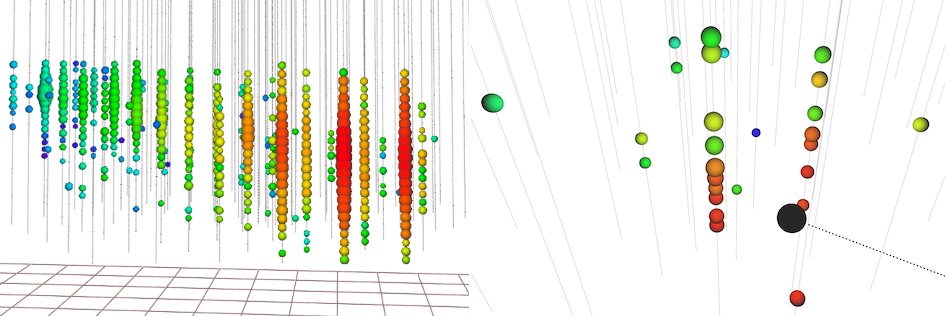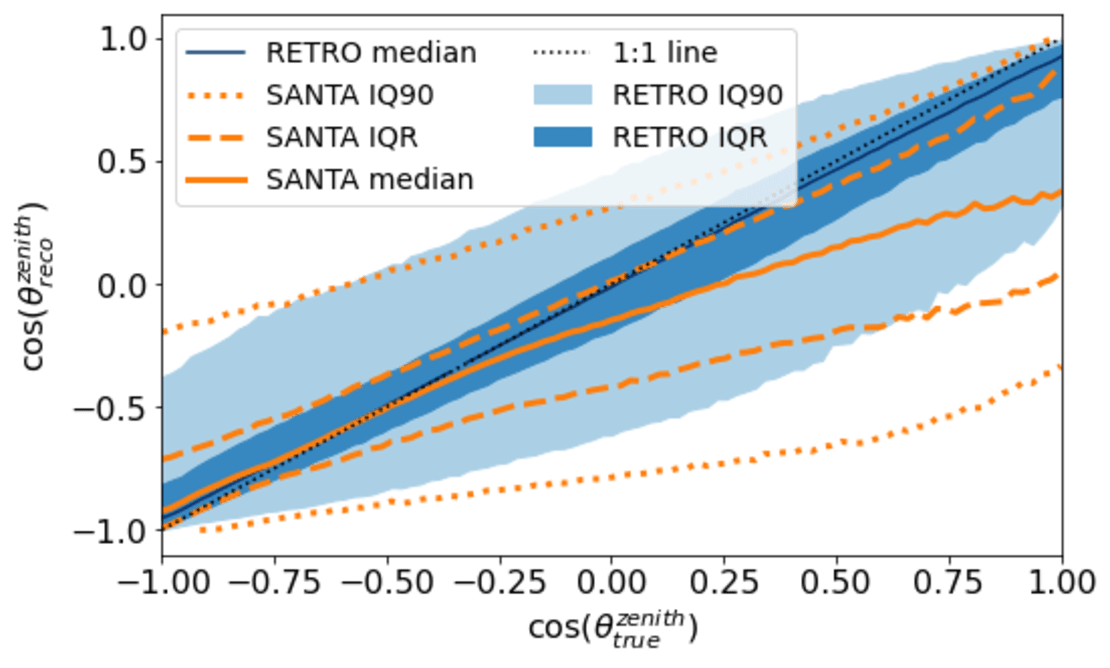Every six minutes, a neutrino flies through the Antarctic ice sheet, and close to an IceCube sensor—also called a DOM—it interacts with a molecule of ice and creates a tiny amount of light that triggers data-taking for an event in the IceCube neutrino detector. If this is a high-energy event, a beautiful track or a spherical cascade of light propagates through the ice, creating the well-known, colorful signatures of astrophysical neutrinos.
However, most of the time, the origin of this neutrino is the interaction of a cosmic ray with the atmosphere. That neutrino could have an energy of only a dozen or so GeVs and will only create sparse light pulses. Low-energy neutrino interactions are the focus of many physics analyses, within and beyond the Standard Model, which is why IceCube collaborators have developed increasingly sophisticated algorithms to reconstruct the incoming direction and energy of atmospheric neutrinos.
In a new paper submitted today to the European Physical Journal C, the IceCube Collaboration presents two algorithms that reconstruct the energy and direction of low-energy neutrinos with great precision.

Neutrinos of a few to a few dozen GeVs go unnoticed in most of the IceCube detector, because the light they produce is too faint to be picked up by the sensors, which are located 125 meters apart and buried at depths from 1450 to 2450 meters. However, in the bottom, central part of this instrumented cubic-kilometer IceCube array, a few extra strings of detectors, with denser spacing and higher quantum efficiency sensors, allow the detection of these low-energy neutrinos. This is the so-called DeepCore subarray, designed for the study of neutrino oscillations as well other particle physics topics such as dark matter, which in the case of anomalous behavior would point to new phenomena beyond the Standard Model.
The two algorithms presented in this study offer two different approaches for the reconstruction of low-energy events: a fast yet robust algorithm that only selects events with mostly unscattered light and a second, slower but superior algorithm that exploits the full detail of each event and accounts for the intricate optical properties of ice that produce the scattering and absorption of light.

The SANTA algorithm, an acronym for “the single-string ANTARES-inspired analysis,” is a fast reconstruction method that relies on direct photons in the events that concentrate in a few DeepCore strings. It offers an improved zenith angle reconstruction with respect to previous methods for unscattered photon events.
The RETRO algorithm, instead, can handle scattered light and can be applied to all events. While the second, more detailed algorithm consumes up to 200 times more computing resources, it also yields a better reconstruction of IceCube DeepCore events. “Every improvement in event reconstruction algorithms directly and positively affects the scientific outcome of IceCube analyses,” explains Philipp Eller, an author of this paper and a postdoctoral researcher at the Technical University of Munich.
Both reconstructions were compared to each other on a common set of events, and RETRO was also tested on a larger event sample. The comparison showed that SANTA exhibits a bias towards upgoing events, while RETRO does not, and its derived computed values are shown to be very close to true direction in a sample of MonteCarlo events. “SANTA and RETRO are a key component of nearly all current and upcoming DeepCore analyses,” explains Kayla Leonard DeHolton, a PhD candidate at the University of Wisconsin–Madison and a coauthor of this work. RETRO is currently used as the baseline reconstruction algorithm for low-energy oscillation studies as well as searches for light sterile neutrinos and other nonstandard interactions in IceCube DeepCore.
But the improvements to the reconstruction of low-energy neutrinos have not yet peaked and continue to be an actively researched topic in IceCube. Currently, machine-learning approaches have gained traction, and IceCube collaborators hope to bring more positive news in the near future. Stay tuned!
+ info “Low Energy Event Reconstruction in IceCube DeepCore,” IceCube Collaboration: M. G. Aartsen et al., European Physical Journal C 82 (2022) 9, 807, link.springer.com, arxiv.org/abs/2203.02303